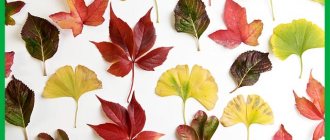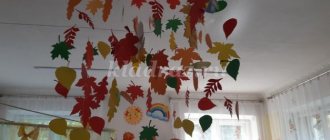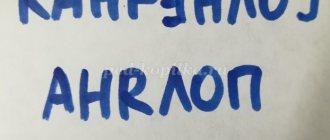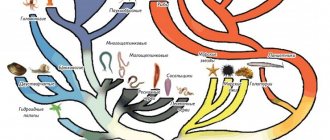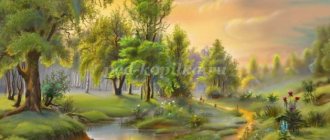Autumn is outside
Summary of educational activities to familiarize yourself with the surrounding world in a preparatory group for school
Target:
formation of ideas about the autumn season.
Tasks:
- consolidate ideas about the seasons and their sequence;
- expand knowledge about autumn changes in nature;
- repeat the concepts of “sound”, “word”;
- introduce new words and expressions, properties and qualities of phenomena and objects into children’s active vocabulary;
- motivate children to freely conduct an active dialogue, actively speak out, justifying their opinions;
- learn to compose short descriptive stories, including using a diagram;
- develop logical thinking and coherent speech, creative imagination, auditory and visual attention;
- cultivate interest in native nature and its knowledge.
Preliminary work:
reading and discussing children's literature on the theme “Autumn”; observation of leaf fall and autumn changes in the nature of the city, on the territory of the kindergarten. Conducting didactic games “Guess which tree”, “Leaf fall”, “What came first”. Printing with autumn leaves, appliqués, modeling “Mushroom basket”. Listening to the music of P. Tchaikovsky “The Seasons” “Autumn”.
Materials:
illustrations “Seasons”, K. Ushinsky’s book “Four Wishes”, autumn leaves (from birch, oak, maple), pictures depicting these trees, a basket of vegetables and fruits, ears of wheat, rye, a diagram for compiling a descriptive story , several plot pictures and landscape paintings on the theme “Autumn”.
Equipment for the experiment according to the number of children:
flat dishes with dry soil, a strip of dark-colored sandpaper in the form of a path, trays, napkins, small watering cans with water.
Progress of the lesson
Educator :
Hello, guys.
Look at the book in my hands. What is the name of this story by K. Ushinsky? Why did the author call it not three, not five, not six, but four wishes? ( The teacher praises the children for correct, reasoned answers.
)
Educator:
I offer you the game “What is earlier, what is later?”
Please answer my questions. What happened before autumn? And later? What happened before summer? And before spring? And later in winter? ( Children answer and sit on chairs standing nearby in a semicircle facing the floor board.
)
Educator:
You did great.
Now a new game is “Find the Bug”. ( The teacher invites several children to place illustrations of 4 plot paintings “Seasons” on the board in the correct sequence and name them in order.
)
Educator:
How many months are there in a year?
How many autumn months are there? Name them. ( Children's answers
.)
Educator:
What vowel sounds do you know?
[A], [O], [I], [Y], [U], [E] and [IA], [IYU], [IE], [YO]. Let's sing them. Why are these sounds called vowels? What seasons begin with the vowel sound [O]? Now name the words that begin with the sound [O], and I will write them down. ( The teacher writes down the words the children call in a column. Then the children select definition words for these words.
)
Educator:
Guys, let's try to play with words. Let's substitute the same definition words for the word “Autumn”. What did we get?
Children:
Autumn is damp, beautiful, boring, soft, gloomy, cheerful, fearful.
Educator:
Can you say that about autumn or not?
Why? ( Children think, express their opinions, argue, prove. The teacher summarizes the children’s statements.
)
Educator:
And now we will conduct an autumn physical education session.
( The teacher scatters leaves of different colors and shapes (maple, oak, birch) all over the carpet.
) What is the name of this autumn natural phenomenon?
( Leaf fall
.) From what words was this word formed?
( Leaves + are falling.
) Let's collect leaves, but not all in a row, but of our choice only from one tree.
You can admire them, rustle, dance, run. ( Pictures of oak, birch, maple are hung on the board.
)
Educator:
Now find your tree!
( Children find their tree, run up to it, identify it, compare it by leaves.
)
Educator:
Children, close your eyes and imagine autumn in the form of a person.
( The music of P.I. Tchaikovsky “The Seasons” sounds. The children close their eyes, and the teacher speaks quietly.
) Each of you has your own autumn... Who do you imagine autumn to be?
And you? Describer her. ( 3-4 children answer. Children name and describe imaginary images of autumn. The teacher summarizes the children’s answers.
)
Educator:
Now for a moment of questions.
Why can you see fewer people wearing high rubber boots in the city in the fall than in the countryside? Where do we live in a city or village? What is the name of the asphalt path that people walk on? ( The teacher suggests going to the tables and removing the napkins from the trays.
)
Educator:
Let's move on to experiments.
What does the dark stripe look like? ( Pavement
.) Where are there more asphalt roads and sidewalks?
Walk your toes along the sidewalk. What is he like? ( Dry, rough, clean.
) Now walk on the ground, compare the sensations.
What do you think the weather was like here? ( Sunny, dry.
) Let's make it rain!
( Children use a small watering can to water the experimental surface.
) Walk along the sidewalk.
What are your fingers like now? ( Wet, damp, moist, clean.
) Walk along the ground in the village.
What happened to your fingers? ( They got dirty. Children speak out and come to an answer to the question posed.
)
Children:
It is dirtier in the village in autumn, so people wear rubber boots.
Educator:
So they say about rainy weather: “slush, damp.”
( Children repeat new words.
)
Educator:
If you were fashion designers, what color fabric would you choose for your fall outfit?
( Children's answers.
) Let's look at paintings on the theme “Autumn.”
( While the children are looking, the teacher hangs a plan diagram on the board for compiling a descriptive story “Autumn.”
)
Educator:
And now we will summarize everything we saw and new into a story about autumn.
( Two forms of work: collective and individual
).
Educator:
Well done! I liked your stories about autumn.
Lyudmila Nagornova, teacher, MADOU D/s No. 7 , Salavat, Bashkortostan
MAGAZINE Preschooler.RF
Nikitina Inna Alexandrovna EducatorProgram content: 1. Teach children to recognize and name the autumn months. Introduce the popular names of September, October and November. 2. Develop memory, speech, intelligence. 3. Cultivate curiosity. Expand children's knowledge about natural phenomena. Vocabulary work: Howler, deciduous, deciduous. Material: Autumn leaves, stump, forester and autumn costume, 12 drawings “Seasons”, recording “Visiting a fairy tale”. Preliminary work: Repeat concepts in the form of didactic games: year, month, weeks, day. Reading poems about autumn, autumn signs. Progress of the lesson: Teacher: “Guys, a telegram arrived in our group today.” (Showing it to the children) - Do you want to know what is written there? (children's answers)
(Reading the telegram) Dear guys, I invite you all to visit me. Educator: But I don’t know who wrote this telegram. Let's guys go into the forest and find out: “Who invited us?” (Children are included in the group). The recording “Visiting a Fairy Tale” is turned on. Educator: Look, guys, how beautiful it is in the forest. What do you see here? (Children's answers) An old man appears - a forest boy. Old man - forest boy: - Hello guys! (Children say hello) The teacher and children ask: “You don’t know who invited us to visit the forest, was it you?” Old man - forest boy: No, it’s not me. But I will help you. But only you must first unravel and interpret my tale. Educator: Let's try, guys! (we seat the children in a semicircle) Old man - forest boy: - Lives - lives an old man - a year old, where he lives - no one knows. One day he began to wave his arms and let birds fly. And each bird has its own name. The old man waved for the first time, and the first three birds flew away. There was a whiff of cold from the wings, and white snow was falling off the feathers. The old man waved a second time and the second troika flew off. The snow began to melt, the grass came to life, and flowers appeared. The old man waved for the third time, and the third troika flew off. The sun began to warm, the bread ripened in the field. And for the fourth time the old man waved and three more birds flew. The wind blew, the leaves and grass turned yellow, the earth was dressed in a golden outfit. But the birds were not simple; each bird had 4 wings, but each wing had 7 feathers, but each feather had its own name. One half is white, the other is black. The bird flaps once, it becomes light - light, another wave - dark - dark. The old forester: “Now tell me, guys, what kind of triples did the old forester produce? What are the 4 wings of each bird? What are the 7 feathers in each wing? And how can you understand that each feather has one half black and the other half white?” (Children's answers) Old man - forest boy: - Well done guys! The fairy tale is tricky, but you figured out all the tricks. Now guess who invited you here: She comes when the fields are empty, the earth is yellow, the leaves fall, the rain pours, when does this happen? (Children's answers) Old man - forest boy: - Yes, it's autumn. The time has come to invite our mother autumn to us: - Autumn, golden autumn (we walk in a circle) Come autumn with joy (bow) With great mercy With a high loaf (pull yourself up) With a deep root (bend down) With strong rains (clasp your hands) With gifts abundant (hands forward) (Repeat 2 times) (Autumn is coming) Autumn: I decorated the forests I hung cobwebs and tidied up the Earth for the holiday I came from afar and brought a lot of joy and fun. Autumn: - Hello, dear guests, there are so many of you. Have you seen my kids? Educator: - Who are your kids? Autumn: - I have three sons: September, October, November. (shows pictures) The oldest is September, people often call him Howler. Old man - forest boy: - Guys, why do you think he is called that? (Children's answers) Educator: - What else can you call it? (Children's answers) Autumn: - The middle son is October. It comes just after September. The people gave him the same affectionate name - deciduous. Old man - forest boy: - Why was he called that? Educator: - What would you call him? (Children's answers) Autumn: - And the youngest son is November. The people also love it and nicknamed it Leafy. (the teacher asks the same question)) - I have photographs of their cousins too. (Takes out other pictures) (The old man selects the photographs and confuses them) Autumn: - What have you done, forest boy, how can I now find my guys among them? Educator: - Guys, let's help autumn find her kids in the photo. (Children are looking) Autumn: - How did you guys know that these were my kids? (Children's answers) Autumn: Thank you guys, and for your help you will receive gifts from me. (Hands out one yellow piece of paper) - Goodbye, dear guests. And now the forester and I will go into the forest to look for my boys. And if, guys, they come to you, you will recognize them from their photographs. (Autumn and the forest boy leave) Educator: Guys, where did we go today? (children's answers) Educator: Oh, guys, autumn took the photographs with it. Apparently I forgot to leave it. What to do now? How will we recognize her children? Let's draw. -Did you remember everything? (Children's answers) We seat the children at the table Educator: Children, what did you draw? (Children's answers) - What do people call them? (Children's answers) - Why do they call them that? (Children's answers) - Well done, guys, your drawings turned out well. Now we will hang them in our corner, and we will know who they are: September, October and November.
| Next > |
ECD “Late Autumn” using ICT (preparatory group)
Abstract of the GCD on the topic: “Autumn” in the preparatory group
Purpose: to introduce seasonal phenomena through familiarization with masterpieces of painting, poetry and music Program objectives: Educational: - to introduce the seasonal phenomena of late autumn - to expand ideas about the work of composers, poets, artists, their works Developmental: - enrich vocabulary - continue to teach to feel, understand and reproduce the figurative language of a poem, - continue to teach to depict natural phenomena described in the poem, convey content using expressive means (composition, color) Educational: - cultivate a love for poetry, painting , native nature.
- develop aesthetic taste Demonstration material: - slides: paintings by V. Polenov “Early Snow”, photos about late autumn - audio recording of music by A. Vivaldi “Autumn”, P. I. Tchaikovsky “November” (from the cycle “Seasons”) Handout materials: - watercolor paints, sippy cups, paper for watercolors, brushes Preliminary work: memorizing poems by A. S. Pushkin “The sky was already breathing in autumn”, S. Yesenin “The fields are compressed, the groves are bare”, conversations about the signs of late autumn Progress of the lesson :
- Guys, listen carefully, don’t interrupt, what month is this, well, guess: The field has become black and white: It’s raining, then snow is falling. And it got colder - the waters of the rivers were frozen with ice. The winter rye is freezing in the field. What month is it, tell me? Children's answer: this is the month of November. - Let's remember the poem by A. S. Pushkin “Already the sky was breathing in autumn”? The sky was already breathing in autumn, the sun was shining less often, the day was getting shorter, the mysterious canopy of the forests was revealed with a sad noise, fog was settling on the fields, a caravan of noisy geese was stretching to the south: a rather boring time was approaching; It was already November outside the yard. — November is the last autumn month. And what signs of deep, late autumn are shown in the poem? Sample answers from children: The sun appears less often, it’s cold outside, the days are getting shorter, the forest is becoming bare, birds are flying south. — How do you understand the expression “The mysterious canopy of the forests was revealed with a sad noise”? Children: all the leaves have fallen off the trees. - Why does the summer noise of leaves seem cheerful to us, and the autumn noise sad? Children's answers. - What other poems do you know about late autumn? Children read poetry: ***A. Pleshcheev Summer has passed, Autumn has come, The fields and groves are empty and sad. The birds have flown away, the days have become shorter, the sun is not visible, the nights are dark, dark. ***A. Pleshcheev Autumn has come, the flowers have dried up, and the bare bushes look sad. ... A cloud covers the sky, the sun does not shine, the wind howls in the field, the rain drizzles. ***WITH. Yesenin The fields are compressed, the groves are bare, There is fog and dampness from the water. The sun quietly rolled down like a wheel behind the blue mountains. The dug-up road sleeps. Today she dreamed that there was very, very little time left to wait for the gray winter. -What is autumn in all these poems? Children: sad, gloomy, cold. - Yes, guys, the leaves have fallen off the trees, the grasses have turned brown, drooped, and the flowers have withered. Only the spruce and pine trees are still green. -What happened to the lush, colorful carpet of leaves that covered the ground? Children: the leaves have faded and darkened. — Autumn is like the evening of the year. And in the evening we get ready for bed. So the trees took off their clothes and washed themselves with the rain. The earth is falling asleep. I wonder what she'll dream about? Children: - Autumn does not stand still. She is heading towards winter. The day will come when it snows. Let's call this day “the gates of winter.” And now we will play the game “Gate” Game “Gate” - Two children will hold hands and depict a gate. And the rest will pass through the gate, saying who they are, naming the signs of autumn (frost, long nights, gloomy clouds, frost on the branches, short days, first ice, short days, cold rains, gusty cold winds). If someone makes a mistake, the gate will not let him through. — Guys, every season gives us a lot of beauty and creativity. In autumn, every day you can see some changes and transformations. Let's try not to miss them. Listen to how composer Pyotr Ilyich Tchaikovsky conveyed his mood from late autumn. But what autumn is like for Vivaldi. (musical fragments sound) - Whose music did you like best? What do these works have in common? What is their difference? — Look at the reproduction of V. Polenov’s painting “Early Snow.” What do we see in the picture? Teacher's story: According to Polenov, he saw “from the window of his workshop: snow fell completely unexpectedly, when the forest had not yet shed its autumn dress, and there was still a real “golden autumn.” The artist was struck by the state of frozenness, the numbness of nature, still retaining the warmth of autumn days, before the unexpected cold that covered the ground with snow and stopped the flow of the river. The composition of the painting was carefully thought out by the artist. In the foreground are trees that have not yet shed their autumn leaves, followed by a river ribbon running into the distance. On the horizon there is a gray-blue sky overcast with clouds, the cold distances of endless expanses. The leaves on the trees are accurately and gracefully drawn. What signs of late autumn did you see in the picture? Children: the sky is covered with heavy (lead) clouds, the river has not frozen yet, leaves are hanging on the trees here and there, and snow has already covered the ground. - November plays on the ice harp, opens the gates to Mother Winter. This time at the very end of autumn is called pre-winter or “Silver Autumn”. - And now we will try to depict late autumn. Children draw, music by Tchaikovsky and Vivaldi sounds. Analysis of children's drawings. When analyzing works, we pay attention to the color scheme, accuracy in work, and composition of the drawing.
We recommend watching:
Summary of the GCD in the preparatory group on the topic “Paintings by artists” Walks with the child in the fall Summary of a recreational and educational lesson on traffic rules in the preparatory group Synopsis of the GCD for FEMP in the preparatory group on the topic “Visiting Professor Aquarius”
Similar articles:
Summary of educational activities on cognitive and speech development in a speech therapy group preparatory to school
Summary of educational activities on cognitive and speech development for a speech therapy group preparatory to school
Summary of GCD with elements of non-traditional types of gymnastics in the preparatory group for the educational field “Physical Education”
Outline of GCD in the preparatory group
Summary of educational activities on cognitive development in the preparatory group
